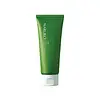What's inside
What's inside
 Key Ingredients
Key Ingredients

 Benefits
Benefits

 Concerns
Concerns

 Ingredients Side-by-side
Ingredients Side-by-side

Water
Skin ConditioningKaolin
AbrasiveLauryl Glucoside
CleansingHectorite
AbsorbentGlycerin
HumectantTitanium Dioxide
Cosmetic ColorantFucus Serratus Extract
Skin ProtectingMelaleuca Alternifolia Leaf Oil
AntioxidantCitrus Grandis
Citrus Aurantifolia Oil
CleansingPentylene Glycol
Skin ConditioningGlycolic Acid
BufferingAllantoin
Skin ConditioningMenthol
MaskingSodium Benzoate
MaskingPEG-7 Olivate
EmulsifyingCamphor
MaskingDisodium EDTA
Tranexamic Acid
AstringentPiroctone Olamine
PreservativeHydrogenated Polydecene
EmollientCetyl Ethylhexanoate
EmollientPolyquaternium-51
Skin ConditioningPhospholipids
Skin ConditioningKalanchoe Spathulata Extract
AntioxidantWater, Kaolin, Lauryl Glucoside, Hectorite, Glycerin, Titanium Dioxide, Fucus Serratus Extract, Melaleuca Alternifolia Leaf Oil, Citrus Grandis, Citrus Aurantifolia Oil, Pentylene Glycol, Glycolic Acid, Allantoin, Menthol, Sodium Benzoate, PEG-7 Olivate, Camphor, Disodium EDTA, Tranexamic Acid, Piroctone Olamine, Hydrogenated Polydecene, Cetyl Ethylhexanoate, Polyquaternium-51, Phospholipids, Kalanchoe Spathulata Extract
Water
Skin ConditioningBentonite
AbsorbentSodium C14-16 Olefin Sulfonate
CleansingTitanium Dioxide
Cosmetic ColorantPumice
AbrasivePropylene Glycol
HumectantVinegar
Kaolin
AbrasiveXanthan Gum
EmulsifyingMagnesium Aluminum Silicate
AbsorbentCocamidopropyl Betaine
CleansingDisodium EDTA
Citric Acid
BufferingDiazolidinyl Urea
PreservativeMethylchloroisothiazolinone
PreservativeMethylisothiazolinone
PreservativeParfum
MaskingHexyl Cinnamal
PerfumingCI 15985
Cosmetic ColorantCI 16035
Cosmetic ColorantWater, Bentonite, Sodium C14-16 Olefin Sulfonate, Titanium Dioxide, Pumice, Propylene Glycol, Vinegar, Kaolin, Xanthan Gum, Magnesium Aluminum Silicate, Cocamidopropyl Betaine, Disodium EDTA, Citric Acid, Diazolidinyl Urea, Methylchloroisothiazolinone, Methylisothiazolinone, Parfum, Hexyl Cinnamal, CI 15985, CI 16035
Ingredients Explained
These ingredients are found in both products.
Ingredients higher up in an ingredient list are typically present in a larger amount.
Disodium EDTA plays a role in making products more stable by aiding other preservatives.
It is a chelating agent, meaning it neutralizes metal ions that may be found in a product.
Disodium EDTA is a salt of edetic acid and is found to be safe in cosmetic ingredients.
Learn more about Disodium EDTAKaolin is a clay. It is used for oil control and to help minimize pores. Like other clays, kaolin has the ability to absorb excess sebum or oil. This can help clean out pores and mattify the skin.
Some types of kaolin may have exfoliating properties. When water is added to kaolin, it becomes a paste with small abrasive particles.
Most kaolin is a white color, but may be pink/orange/red depending on where it comes from.
The name 'kaolin' comes from a Chinese village named 'Gaoling'. Kaolin clay comes from rocks rich in kaolinite. Kaolinite, the mineral, has a silicate layered structure. Kaolinite is formed from chemical weathering of aluminum siilicate minerals.
Besides skincare, kaolin is commonly used to make glossy paper, in ceramics, toothpaste, and as medicine to soothe stomach issues.
Learn more about KaolinTitanium dioxide is a mineral UV filter widely used in sunscreens and cosmetics.
It is one of only two UV filters officially classified as “mineral” by regulatory agencies, the other being zinc oxide.
Titanium dioxide provides broad-spectrum protection mostly in the UVB and UVAII range, with some protection in the UVAI range.
While its UVA protection isn’t as strong as zinc oxide’s, the difference is minor.
A common myth is that mineral UV filters reflect UV light. However, modern research shows titanium dioxide absorbs UV radiation like chemical filters (~95% absorption & 5% reflection).
Thanks to its non-irritating nature, titanium dioxide is suitable for sensitive, acne-prone, or redness-prone skin. It is unlikely to cause "eye sting" like other sunscreen ingredients.
A major drawback of this ingredient is its white cast and thick texture. This is why mineral sunscreens often leave a white cast and are less cosmetically elegant than chemical/hybrid sunscreens.
To improve white cast and spreadability, micronized or nano-sized titanium dioxide is often used.
There are ongoing concerns surrounding nano-titanium oxide's impact on marine ecosystems.
There is no conclusive evidence that any form of titanium oxide (or any other sunscreen ingredients) will cause harm to marine ecosystems or coral reefs. The science is still developing but many consumers are keeping a close eye on this issue.
Please note, many destinations have reef-safety sunscreen rules. For instance, the U.S. Virgin Islands advises all visitors to use non-nano mineral sunscreens.
Nano mineral sunscreens once raised safety concerns about absorption into skin.
Extensive research has shown that they do not penetrate healthy or damaged skin; they remain safely on the surface and the top layer of dead skin (stratum corneum).
You'll likely find titanium dioxide bundled with alumina, silica, or dimethicone. These ingredients help make titanium dioxide highly photostable; this prevents it from interacting with other formula components under UV light.
Learn more about Titanium DioxideWater. It's the most common cosmetic ingredient of all. You'll usually see it at the top of ingredient lists, meaning that it makes up the largest part of the product.
So why is it so popular? Water most often acts as a solvent - this means that it helps dissolve other ingredients into the formulation.
You'll also recognize water as that liquid we all need to stay alive. If you see this, drink a glass of water. Stay hydrated!
Learn more about Water